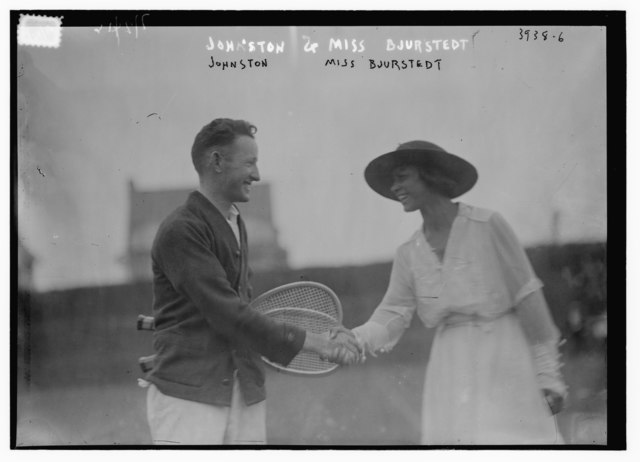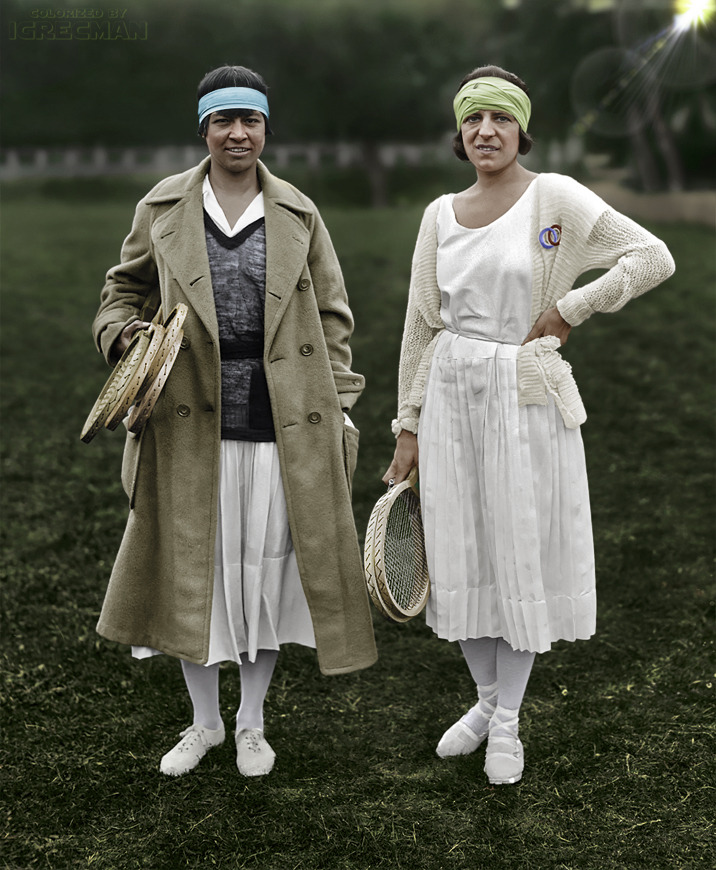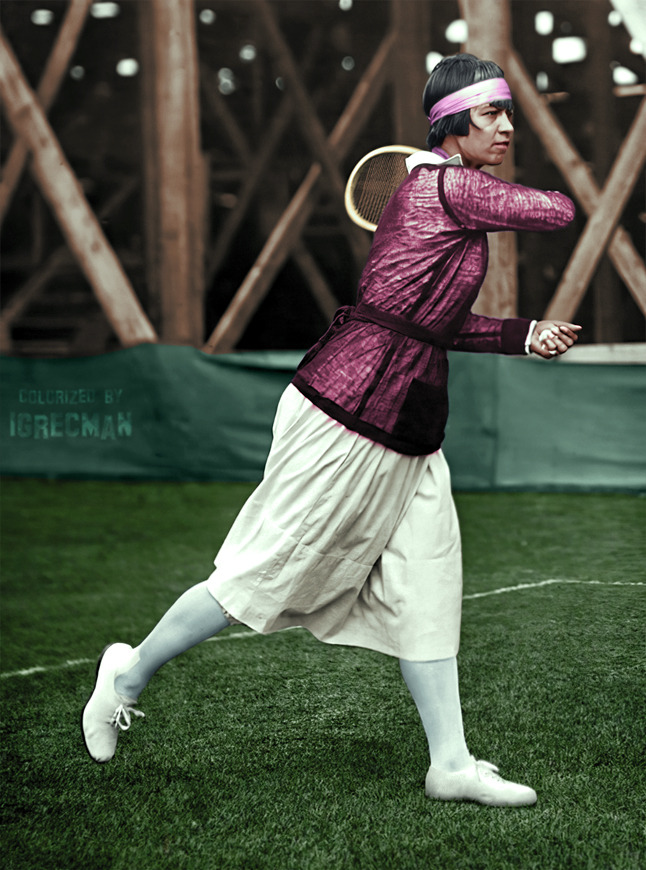In 2022, I’m counting down the 128 best players of the last century. With luck, we’ll get to #1 in December. Enjoy!
* * *
Molla Mallory [NOR/USA]Born: 6 Mar 1884
Died: 22 November 1959
Career: 1903-29
Plays: Right-handed (one-handed backhand)
Peak rank: 2 (1921-22)
Peak Elo rating: 2,178 (1st place, 1915-18)
Major singles titles: 8
Total singles titles: 100 (not including pre-1915 Norwegian titles)
* * *
My favorite origin story for a sports legend belongs to chess player Bobby Fischer. He first took up the game at age six. Soon after, he started spending time at the Brooklyn Chess Club, where his enthusiasm morphed into obsession.
He was talented, but by the sky-high standards of chess, he was no prodigy. He won a lot, but not all time. Then, as he later wrote, “When I was eleven, I just got good.” In two years, he won the US Junior Chess Championship, and he got the better of a former adult champion in a masterpiece dubbed “The Game of the Century.” At 14, he won the national title himself.
Fischer didn’t try to explain his remarkable improvement. He was working with a renowned coach and studying constantly, but there was no accounting for the sudden leap forward. While few performers in any field have improved as fast and become as great as Fischer did in that span, an inexplicable breakthrough is common enough. It’s just that most athletes–and perhaps to an even greater extent, their biographers–don’t want to admit it.
There are few sporting greats with less in common with Bobby Fischer than Molla Mallory. She was born, in Norway as Anna Margrethe Bjurstedt, sixty years before the chess savant. At age 30, she had done little to establish an international reputation. To the contrary, she was working as a masseuse in Canada, taking a forced break from tennis. Unlike Fischer, she’d never be called a genius. On the rare occasion that commentators would bestow such praise on a female tennis player, the word was reserved for Suzanne Lenglen.
Yet Molla’s rise, from a big fish in a tennis backwater to an eight-time champion at the US Nationals, is every bit as puzzling as Fischer’s transformation. She pretended that it all made sense, explaining that she shored up her backhand and worked on her serve. But when Mallory left her native country in 1914, absolutely no one could have foreseen that within a year, she’d be the best player in America, or that 13 years later, she’d still merit a spot among the world’s top five.
* * *
Molla Bjurstedt first picked up a tennis racket in 1902, at age 18. (She would become Mrs. Franklin Mallory upon her marriage in 1919.) She played her first tournament at the Oslo Tennis Club in December of that year, losing in the first round of singles and doubles. But she was a quick learner, and she had a reliable practice partner in her younger sister Valborg. In 1904, Molla won her first unofficial national championship, and she quickly ran out of competition, even beating most of the male players at her home club.
Oslo (then called Christiania) was far off the usual tennis circuits of the day, but Bjurstedt occasionally enjoyed a taste of the international game. She and her sister regularly played doubles with Sweden’s King Gustav and his son, the crown prince. In 1910, Wimbledon champion Anthony Wilding passed through. He invited Molla to lunch, where he explained the training regimen necessary to become a champion.
It was several years after she began playing that Bjurstedt dipped her toe into foreign tournaments. Trained as a masseuse, she traveled to London in 1909 to practice her profession there. She entered Wimbledon and lost in her first match to Edith Johnson, the 1908 runner-up. She and Valborg traveled to Germany in 1911, where she lost a three-set final at the German Championships in Hamburg.
In 1912, she competed in the outdoor singles event* at the Stockholm Olympics. She took home a bronze, but it was hardly a breakthrough. Only twelve women entered, all from Europe, and four withdrew without hitting a ball. Molla earned her medal by winning a single match against a Swedish player, Edith Arnheim, whose main claim to fame is losing that third-place contest.
* There were separate indoor and outdoor tennis tournaments at the 1912 Olympiad. Bjurstedt wanted to enter both, but in her telling, the national association was unwilling to enter her in the indoor event because it would mean that Norway was represented solely by a woman.
After two more years of easy wins against local competition, Bjurstedt decided to follow the route of hundreds of thousands of her countrymen and try her luck across the Atlantic. In late 1914, she first headed to Canada, where she continued to work as a massage therapist. She made it to New York City a few months later.
She popped her head in at the Seventh Regiment Armory, where the men’s 1915 National Indoor Championships were held in February. She discovered that the women’s event was scheduled for the following month.
Molla entered, and suddenly, she just got good.
* * *
Molla Bjurstedt’s 1915 season was outstanding by any standard, let alone that of an unknown playing her first tournaments in the United States. At her first tournament, she won five matches without the loss of a set. She triumphed in the title match over Marie Wagner, runner-up at the 1914 national championships.
In May, she won the West Side Tennis Club Championships, defeating 1906 national champion Helen Homans McLean in the final. Already, the public was aware of the newcomer, and the gallery filled up with curious onlookers.
Molla added another title a week later at the New York Metropolitan Championships, beating McLean again in the semi-final, and dropping only four games in the final to Maud Barger-Wallach, the 1908 national champion. Only injury could stop her. Bjurstedt tacked on yet another title in May at Pelham Manor, then ran her winning streak to 19 before she was forced to retire in the quarter-finals at the Morristown Field Club.
She recovered in time to play the US National Championships, then held at the Philadelphia Cricket Club and scheduled in June. Bjurstedt met Hazel Wightman–winner at this event in 1909, 1910, and 1911–in the final. Wightman won the first set, but Molla quickly learned how to outfox yet another first-time opponent, reversing the momentum and sealing a victory, 4-6, 6-2, 6-0.

The Norwegian’s run in Philadelphia kicked off another winning streak, this one reaching 23 matches, including another victory against Wightman in the final of the US Clay Courts event in Pittsburgh. In November, she traveled to California, where she got her first taste of tennis on asphalt and her initial encounters with May Sutton Bundy. Bundy was a two-time Wimbledon champion and queen of the West Coast courts. The Californian won two of three, proof–at last–that Molla was still human.
Regardless of her performance against Bundy, Bjurstedt’s US debut campaign was a stunner. She had secured the national championship along with the national clay court and indoor titles. She won 12 tournaments in all, spanning nearly 70 singles match wins, and she proved capable of beating every player of note in the country.
* * *
For the next seven years, Molla’s dominance over American tennis would be total. She won all but one of the eight national championships between 1915 and 1922, losing only a semi-final in 1919 to Marion Zinderstein.
Zinderstein interrupted a truly astounding streak. When defeat finally came, the now-married Molla Mallory hadn’t lost a tournament match in three and a half years. She wouldn’t lose another in the United States until the 17-year-old Helen Wills overpowered her for the 1923 national title. By then, she was 39 years old, and she still had another US championship ahead of her, when Wills didn’t compete in 1926.
Mallory sustained such a high level thanks in part to a game style that didn’t usually require full effort. She also kept her tennis in perspective. She wasn’t unusually dedicated to training–Anthony Wilding wouldn’t have approved of her late nights and short practice sessions. Molla preferred to keep in shape with lots of match play. At one event that still retained the challenge round, which allowed the defending champion to sit out until the rest of the field had been whittled down to one, she declined the privilege and opted to “play through” instead.
Her game is more difficult to outline, because–in the words of Mallory admirer and future Wimbledon champion Helen Jacobs–she “revolutionize[d] women’s baseline tennis.” The vocabulary that described her style in 1915 had evolved beyond recognition a decade later.
In modern parlance, we’d call her “steady”–a baseliner with a powerful forehand, a reliable backhand, and the willingness to chase down every ball. But when Molla published her instructional book, Tennis for Women, in 1916, she took issue with the term:
I think that ‘steadiness’ is but a negative virtue. My first reason is purely personal; I could not play a ‘safe’ game; there is something so dull and colorless about a game in which one always does the same thing. One loses all the joy of combat in such a style–it is so insipid.
She hardly played a safe game in her first matches against Bundy. The two women, possessors of probably the two most powerful forehands in the women’s game, cheated to their backhand corners and simply clobbered groundstrokes at each other. As good a retriever as she was, the Norwegian was never passive: “I always take the game to my opponent. Attack, attack, attack!”
When Mallory first arrived in the States, such aggression was unusual. The Bundy forehand left opponents reeling, and Hazel Wightman attacked the net. But the tactics that Molla found most common were the “chop stroke”–essentially a drop shot hit with heavy spin–and what we’d now call moonballing.
Mallory did not approve of the chop:
I have never used the chop stroke or a stroke with an excessive top spin. I do not know how to play them and I do not care to learn. … I consider tennis a hard-hitting, placing game and I think speed and placement must eventually win. The player with a great repertoire of cuts may disconcert an opponent for the time being, but so would a server who turned a somersault on her delivery.
And she really did not like moonballs:
I have no patience with the gentle drives which majestically describe tall parabolas.
A lobber seldom wins unless her opponent succumbs to irritable fatigue.
Therefore I unreservedly say that one should lob only when no other play seems possible. I abhor excessive lobbing.
To Molla, “steady” meant passive. By the time she retired in 1929, there were still chop-stroke artists and more than a few moonballers, but it was possible to be both steady and powerful. You had to be, if you had any hope of outplaying Mrs. Mallory.
* * *
For all of Mallory’s dominance in the United States, she was oddly ineffective back in Europe. She traveled to Britain, with occasional trips to France, nearly every year between 1920 and 1929. She won only five tournaments, none of them major events. In nine attempts, she reached the Wimbledon final just once, and she lost badly to Suzanne Lenglen when she got there.
One common explanation was that the fast turf at Wimbledon and other British events didn’t suit her game. She also turned 40 midway through the decade. The court coverage that in the 1910s made spectators think of a panther surely must have become less cat-like.
Still, one of the greatest achievements in Molla’s career came against a European player. Suzanne Lenglen made her sole appearance at the US National Championships in 1921. Earlier in the year, the two women had met in the final of the World Hard Court Championships in Paris, where Lenglen won, 6-2, 6-3. It was closer than the score implied, however. Mallory had a break point when Suzanne was serving at 3-2 in the second set. Lenglen was struggling with blisters on her feet and made some indications that she would default, but coaxed by her father, she continued to play, saved the break point, and quickly sealed the victory.

Colorization credit: Women’s Tennis Colorizations
Lenglen was the best player in the world; she hadn’t lost a singles match–not even a set–since before the war. Americans eagerly anticipated the Lenglen-Mallory clash that would likely decide the US title. But the Forest Hills draw was unseeded, and the two women would meet in the second round.
Molla was confident. After the match in Paris, she told Bill Tilden, “I can beat her! The next time I play her I will beat her.” Tilden was present for the next meeting, as well, and he tried to help her do just that. Helen Jacobs tells the story in her book, Gallery of Champions:
For an hour before the match was called, Bill Tilden, always one of Molla’s greatest friends and admirers, pinned her in a big armchair in the clubhouse. Allowing no one else to talk to her, he proceeded to remind her of all the things about Suzanne that were most annoying to Molla, who had never been at any time too fond of her opponent. He knew that if the things he told her would annoy her enough, she would beat Suzanne if she died in the attempt.
Tilden also bumped into Lenglen before the match. He told Suzanne, “No woman can beat Molla, least of all you!”
Mallory was outstanding, flashing what the New York Times called “superb and apparently unbeatable form” in a front-page story, surely one of a very few times a second-round match merited such prominence. At the same time, Lenglen played “timidly and uncertainly,” and she began to cough midway through the first set. After Molla took the opener, 6-2, they played two more points before Suzanne defaulted.
The ensuing war of words lasted far longer than the match. Tournament officials accused Lenglen of faking. The French Federation certified that Suzanne really was sick. American newspapers had the final word, giving Lenglen the nickname “cough and quit” and hailing their adopted hero like never before.
The Frenchwoman wouldn’t lose another singles match in her amateur career, a 179-match streak that included two lopsided wins over Mallory. Their next meeting came in the title match at Wimbledon in 1922. It was the shortest major final on record. Lenglen finished the job, 6-2, 6-0, in just 23 minutes.
* * *
Molla wrote in 1916: “There is no tennis age; the limit is mental.” Her book was published when she was a 32-year-old rookie sensation, and even then, she could have no idea to the extent to which she’d embody her own words.

Colorization credit: Women’s Tennis Colorizations
She won nearly 200 singles matches after her 40th birthday, including the 1926 US National title. One of her last tournament victories was at the 1929 Essex Invitation in Manchester, Massachusetts, where her quarter-final victim was Sarah Palfrey, a future national champion 28 years her junior.
Like all instructional books, Tennis for Women has its share of well-worn, generic filler. She’s hardly the first, or the last, author to proclaim that age is just a number. Yet coming from Mallory, such stuff still packs a punch.
One last Molla-ism: “It is surprising what may be accomplished by well-directed ceaseless energy.”
When we’re talking about the feats of Molla Bjurstedt Mallory, surprising doesn’t even begin to cover it.

